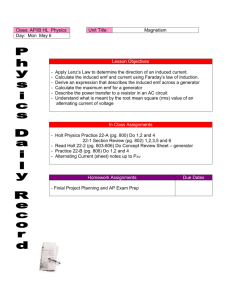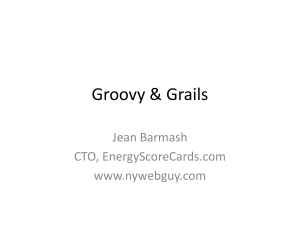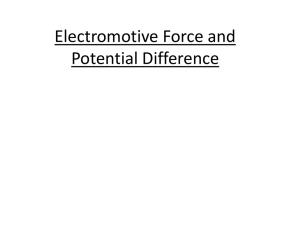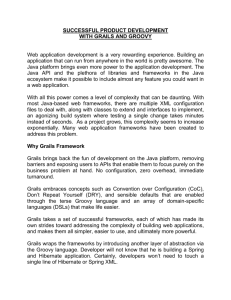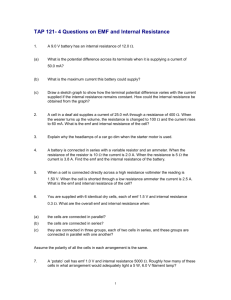Groovy and Grails Meet Eclipse Modelling Framework
advertisement
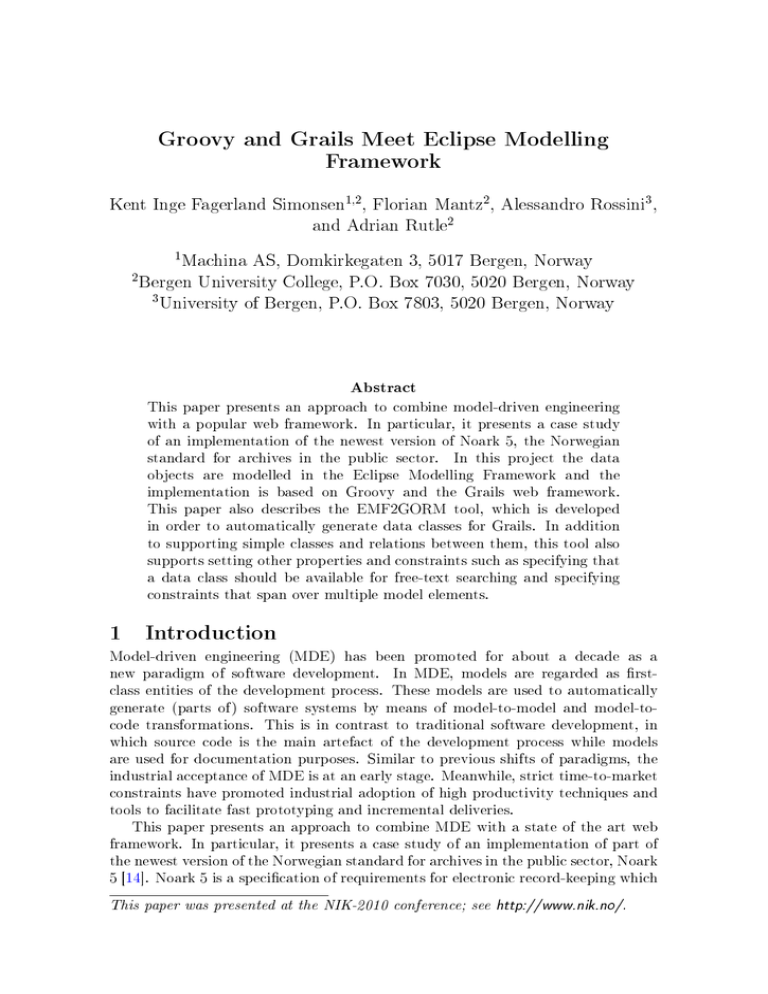
Groovy and Grails Meet Eclipse Modelling
Framework
Kent Inge Fagerland Simonsen
1,2
2
3
, Florian Mantz , Alessandro Rossini ,
2
and Adrian Rutle
1
2
Machina AS, Domkirkegaten 3, 5017 Bergen, Norway
Bergen University College, P.O. Box 7030, 5020 Bergen, Norway
3
University of Bergen, P.O. Box 7803, 5020 Bergen, Norway
Abstract
This paper presents an approach to combine model-driven engineering
with a popular web framework. In particular, it presents a case study
of an implementation of the newest version of Noark 5, the Norwegian
standard for archives in the public sector.
In this project the data
objects are modelled in the Eclipse Modelling Framework and the
implementation is based on Groovy and the Grails web framework.
This paper also describes the EMF2GORM tool, which is developed
in order to automatically generate data classes for Grails. In addition
to supporting simple classes and relations between them, this tool also
supports setting other properties and constraints such as specifying that
a data class should be available for free-text searching and specifying
constraints that span over multiple model elements.
1
Introduction
Model-driven engineering (MDE) has been promoted for about a decade as a
new paradigm of software development.
In MDE, models are regarded as rst-
class entities of the development process. These models are used to automatically
generate (parts of ) software systems by means of model-to-model and model-tocode transformations.
This is in contrast to traditional software development, in
which source code is the main artefact of the development process while models
are used for documentation purposes. Similar to previous shifts of paradigms, the
industrial acceptance of MDE is at an early stage. Meanwhile, strict time-to-market
constraints have promoted industrial adoption of high productivity techniques and
tools to facilitate fast prototyping and incremental deliveries.
This paper presents an approach to combine MDE with a state of the art web
framework. In particular, it presents a case study of an implementation of part of
the newest version of the Norwegian standard for archives in the public sector, Noark
5 [14]. Noark 5 is a specication of requirements for electronic record-keeping which
This paper was presented at the NIK-2010 conference; see
http://www.nik.no/.
is mandatory for all government agencies and administration in Norway. Noark 5 is
loosely based on MoReq 2 [3], the record-keeping standard for the EU. The Noark
5 specications are continuously revised and released.
The implementation of Noark 5 is part of the Friark project [6].
The project
was initiated by Machina AS [13] in the summer of 2009 and is released under the
GPLv3 license [5]. As indicated by the County Governor of Sogn og Fjordane in [4],
a free software implementation of Noark 5 is expected to lead to economical and
qualitative benets.
Friark was allocated very little and sporadic resources. So Machina decided to
exploit its expertise with Groovy [11] and the web framework Grails [8]. However,
in order to facilitate portability, the data classes in Friark were specied using
the Eclipse Modeling Framework (EMF) [2, 15].
EMF/Ecore was prefered over
other formats because Machina has a long-term plan to migrate to model-centric
development and in particular to the Eclipse platform. In order to bridge EMF with
Grails, the tool EMF2GORM was developed to generate code from models. This
tool is an Eclipse plug-in and represents the main contribution of this work.
The remainder of the paper is organised as follows.
technologies and tools used in the Friark project.
Section 2 presents the
Section 3 introduces the
EMF2GORM tool. In Section 4, the benets and issues given by the combination
of EMF with Grails are discussed. Finally, in Section 5 some concluding remarks
and ideas for future work are presented.
2
Technologies and Tools
Groovy
Groovy is a dynamic programming language that runs on the Java Virtual Machine
(JVM). Compared to Java, Groovy allows for compact code through features
such as automatic getter and setter methods for all public elds, extended API
and closures [10].
A closure is a concept introduced by functional programming
languages: it is a rst-class function with free variables that are bound in the lexical
environment. In addition, Groovy enables seamless integration with Java libraries
and can be easily deployed on existing Java environments. These features and the
fact that Machina had existing Groovy expertise made Groovy the preferred choice
for programming language on Friark.
Grails
Grails is a web application framework that is geared towards rapid development [1,
7].
It is inspired by the well-known web application framework Ruby On Rails
(ROR). Like ROR, Grails is based on the code-by-convention paradigm which favours
conventions over congurations. Grails is built as a layer on top of the popular Java
frameworks Spring and Hibernate, which makes it suitable for use in various Java
environments. Grails is implemented in both Java and Groovy, but most applications
based on Grails are implemented using Groovy as the main language.
One of Grails' strengths is in its implementation of the Model-View-Controller
(MVC) pattern.
The controller in Grails consists of Plain Old Groovy Objects
(POGOs), which are analogous to Plain Old Java Objects (POJOs). POGOs in the
controller have a closure for each action.
The view is handled by Groovy Server
Pages (GSP) which are analogous to Java Server Pages (JSP). The main dierence
between JSP and GSP is that GSP pages use Groovy code in scriplet mode and have
its own set of default taglibs. Grails also enables addition of custom taglibs, which
has been exploited in Friark. Furthermore, the model uses Grails' Object Relational
Mapping (GORM), which is the persistence layer in Grails.
This layer builds on
top of the persistence framework Hibernate [12]. The data classes are called domain
classes and are injected automatically with convenient methods such as
list().
save() and
The domain classes themselves are implemented as POGOs. This reduces
the length of the code since the compiler adds getters and setters automatically.
In addition, there are several conventions such as a closure called
constraints
which denes constraints on the objects of a domain class. The Friark project uses
mainly the model part of Grails' MVC implementation since only the data classes
are modelled in the rst stage.
Grails was particularly suited to Machina's need
in the Friark project because it already comes with tools to build controllers and
services.
Eclipse Modeling Framework
Eclipse is a popular integrated development environment (IDE). It is implemented
primarily in Java and can be used to develop applications in e.g. Java and C++.
EMF is a modelling framework built on Eclipse.
EMF is considered a low cost
entry to MDE and is the de facto standard for structural modelling in the Eclipse
community. EMF is also highly extendible by means of plug-ins. This made it a
good choice for Friark since EMF could be extended to transform a EMF model to
GORM classes.
As a part of the code generation process, EMF generates a special version of the
model called a GenModel. The GenModel may contain additional implementation
specic information. In Friark and EMF2GORM any additional information in the
GenModel is ignored. Hence, this step could be skipped and the Gorm classes could
be generated directly from the EMF model.
The code generation process in EMF usually follows three steps:
1. Creation of an EMF model using the tree-based or graph-based editors
provided by EMF/GMF. Alternatively an EMF model can be imported from
other formats.
2. Generation of a GenModel from the EMF model.
3. Code generation from the GenModel.
Another reason to use Eclipse in Friark is its metamodelling capabilities. This
may be used in future versions of EMF2GORM to formalise additional constraints
on the data model and to model and generate the code for other classes such as
controller classes.
3
EMF2GORM
At the beginning of the development of Friark, Machina was not able to nd tools
to generate GORM classes from the EMF model.
Therefore, Machina decided to
develop a new tool, EMF2GORM. One reason to create EMF2GORM was to easily
control the generation process and add new features when the need was discovered.
The tool needed to be general enough that it could be used for other projects
that would rely on EMF and Grails when Friark was completed.
Java Emitter
Templates (JET) [15] were considered for the code generation, but since the authors
had considerably more experience using Groovy and builders [9] than template based
approaches, EMF2GORM was developed using familiar tools.
EMF2GORM Flow
EMF2GORM is called from the view of a GenModel in the EMF editor. It expects
EPackage with several EClasses. Each EClass
of EAttributes, EReferences and EAnnotations.
the GenModel to hold one
may
hold an arbitrary number
How
EAnnotations are handled by EMF2GORM are described in the next section.
For each EClass in the rst EPackage in the GenModel, EMF2GORM creates
a builder that is capable of building GORM classes. Then, the content of EClass
is fed to the builder. When all the content has been fed to the builder, the class
is converted into a textual representation of the GORM class and written to the
appropriate le.
Additional Constraints and Attributes
In order to provide the required functionality in the data layer of Friark, the
functionality of regular EMF models had to be extended.
This is because some
constraints used in Friark were not readily available in EMF. This was done by
EAnnotations
adding special
and handling them while generating the GORM
classes in EMF2GORM. An approach using Object Constraint Language (OCL)
for constraint specication was considered but not realised because this would have
required another transformation from OCL expressions to GORM constraints. This
was not possible because Machina had very limited time and resources for the
project.
The additional constraints were specied in
EAnnotations.
Some of them are
handled by EMF2GORM in the following ways:
Code is embedded directly into the GORM classes'
inList
and
oneOf
constraints.
constraints
closure, e.g.
The former makes sure that an element is
equal to one of the elements in a list, while the latter instructs that at most
one of a set of
EReferences
is set in any instance of the constrained class.
Attributes are generated in the GORM classes, e.g.
loggable
the
searchable
and
constraints. The former instructs some plug-ins of Grails that the
constrained classes should be indexed for full-text searching, while the latter
instructs that operations on the classes should be logged.
It is the authors experience that greater care should have been taken when
dening the
EAnnotations.
Currently, how the
EAnnotations
EMF2GORM is decided by the key-value pairs it contains.
EAnnotation.
EAnnotations,
are interpreted by
In addition, there is
typically only one such pair per
We have started migrating to a more
elegant way of describing the
by using their name to decide their
behaviour. We expect this to make both the usage and the code of EMF2GORM
easier to understand.
The Output
An example of a GORM class generated by EMF2GORM is shown in Listing 1.
This example is the same
FondsCreator
class as shown in Fig. 2.
Listing 1: Sample output
1
package
2
class
org . f r i a r k . ds
FondsCreator
{
3
String
fondsCreatorID
4
String
fondsCreatorName
5
String
description
6
static
constraints
=
{
7
fondsCreatorID ( n u l l a b l e :
8
fondsCreatorID ( unique :
9
fondsCreatorName ( n u l l a b l e :
10
fondsCreatorName ( unique :
11
description ( nullable :
12
d e s c r i p t i o n ( unique :
13
fonds ( n u l l a b l e :
14
fonds ( unique :
false )
true )
false )
true )
true )
true )
true )
false )
15
}
16
static
hasMany =
[ f o n d s : Fonds ]
17
static
mapping
{
18
}
19
20
static
=
searchable
=
[ except :
[ ' fonds ' ] ]
}
4
Experience from Friark and EMF2GORM Development
At the time of this writing, Friark has been in active development using MDE
techniques for nearly a year.
EMF2GORM has been developed in parallel with
Friark and features have been added as the need has arisen in Friark.
One of
the main obstacles in using EMF has been poor availability of documentation on
extending Eclipse and particularly EMF. For instance, it was dicult to nd out how
to extend the GenModel editor with a new command, and to make that command
behave as intended.
This lead to some man-hours spent in reading source-code
and testing dierent extension points. Except for this, there were no big obstacles
to getting the development environment to cooperate properly, besides the general
context switching involved in using dierent environments for dierent tasks.
Table 1 shows the evaluation of using MDE with Grails and EMF2GORM
compared to plain Grails development based on our experience. + denotes that
the combination was a better approach for the given criteria and - denotes that it
was worse.
Since Machina was able to generate a preliminary version of the EMF model
from the Noark 5 specication with most of the classes and attributes already in
place, it is the authors' opinion that MDE made development time slightly faster
in this instance.
This was the case although some time was spent on developing
the EMF2GORM tool for generating the model from the specication. As an added
bonus we were able, as EMF2GORM matured, to reduce bugs in the data layer of
Criteria
Evaluation
Development speed
+
Bug frequency
+
Code consistency
+
Reusability/portability
+
Self documentation
+
Readability of code
-
Communication
+
Table 1: Evaluation of combining Grails with MDE
Friark. At the time of writing no bugs have been reported. This was thanks to the
forced model validation of EMF before generating the GenModel.
Since the code of the application is generated, it is consistent through the entire
data model tier.
The model can be reused by implementing transformations into
other languages, a feature that may be required since Machina searches for new
customers for Friark.
Moreover, the model can be used for documentation and
customer communication which were also benets of this approach. A drawback we
had with the generated code was the reduced code readability. This is because more
code than required was generated such as constraints specifying default behaviour of
Grails. The readability of the code could be improved by improving the generation
of GORM classes.
Approach in Friark
In Friark, an EMF model is used to model all the data classes. This model itself was
partially generated automatically using the Noark 5 specication by using scripts
and tools (see Fig. 1).
The fact that we were able to automatically generate the
model gave us a head start. This helped in representing almost all data structures
that we needed later in the development of Noark 5 in an EMF model even though
at that point some classes had aws. Some of these aws were actually aws in the
tables from the Noark 5 specication. The most noticeable of these were missing
references. These are still being added as the need arises.
The Noark 5 specication includes a document that holds tables describing
most of the attributes and references between the data classes in Noark 5.
specication for the data classes is available as an HTML document.
This
Using the
spreadsheet tool in OpenOce.org and some light formatting, this HTML document
Figure 1: Generation of an EMF model from the Noark 5 specication
was transformed into a comma-separated values (CSV) le. Then, a Groovy script
was developed to transform the CSV le into an XSD le. The XSD le was chosen
as an intermediate step simply because it seemed to be the easiest format that EMF
could import. Afterwards, EMF was used to import the XSD le and generate an
EMF model out of it. Fig. 1 provides a overview of this process. With the EMF
model in place, Machina started working on transforming that model into GORM
classes.
Friark's EMF Model
Friark's EMF model contains 39
EClasses.
Although this is not a very big number,
we did experience some performance problems using the diagrammatic view of
the model.
However, there were no such problems using EMF's tree-based Ecore
Editor. Hence, it became the main way to view and modify the model in Friark.
Diagrammatic views are still used, but mainly for documentation and marketing
purposes. In Fig. 2 an excerpt of the model is shown diagrammatically. This gure
shows the
Base
class on the top which provides the classes extending it with a
universally unique
systemID. Fonds,
to the left, is the class that represents an
entire archive. Each archive is divided into archive-parts which are represented in
Series class in the middle. Archive parts can be divided further
BasicFile, on the right, is the class that represents the simplest folder.
folders extends this class. At the bottom of the gure FondsCreator is
the model by the
into folders.
All other
shown. This class is generated into the class listed in Section 3.
Figure 2: Diagrammatic view of a part of Friark's model
Another problem with using the diagrammatic view of Friark's EMF models is
that many constraints are not visible.
Since some of the new constrains include
programming code (see Fig. 3) much information about the model is missing in the
diagram. Moreover, since the logic of these constraints is specied as source code in
EAnnotation
values, the model validation is not able to validate these constrains.
Figure 3: Example of a constraint written in code
5
In
Conclusions and Future Work
the
project
described
in
this
case
study,
some
techniques
and
tools
for
high productivity web development are combined successfully with MDE. Even
though the platform of choice for modelling was found to be slightly lacking on
documentation, it proved to be relatively easy to extend to generate code for Grails.
In addition, using MDE together with Grails did not seem to slow down development
pace signicantly, even though tools had to be developed from scratch.
The tool that has been developed for Friark, EMF2GORM, has made it possible
to generate the data model with growing condence. Despite its relative immaturity
it is the authors' and Machina's belief that EMF2GORM, with some additional
polishing, will be useful in other projects where data classes are modelled with EMF
and translated to Grails code.
The data model of Friark project was to a large extent predened by the Noark
5 specication. This project is not entirely representative of typical web application
development.
Further studies might be needed to determine if the methods and
tools described here are useful in a more general sense.
EMF models are often the rst choice to build structural models due to the rich
tool set which is provided by EMF. In Friark, we rst created XSD les from the
requirement specication, then we used EMF's possibility to import XSD les and
generate EMF models. There were several constraints in the domain model which
could not be expressed by EMF. For this reason we used
EAnnotations
to extend
the expressive power of EMF. These constraints were manually added to the EMF
model by annotating the model.
Usually
EAnnotations
are used to express features which are not supported
directly by EMF. The code-generation process had to be adapted to handle these
EAnnotations.
Based on our experience in Friark, these annotations are not readable
in the graphical editor and not easily validated automatically. It might be a better
approach to extend Ecore to support these constraints. It could also be benecial
to model more of the application such as controllers in EMF. This would make
the model more comprehensive and also make refactoring easier because more of it
could be done on the model level. Doing these improvements will require to extend
the standard EMF model and editors which requires expertise in Eclipse plug-in
development and EMF's extension points.
References
[1] ALTERthought:
Grails
Vs.
Rails
the
Thrilla
in
Manila:
A
Study
Platform Productivity,
http://alterlabs.com/technologies/java/
grails-vs-rails-the-thrilla-in-manilla-a-study-on-grails-productivity/
on
[2] Eclipse Modeling Framework: Project Web Site,
emf/
[3] European Union: MoReq 2 Standard,
http://www.eclipse.org/
http://www.moreq2.eu/
[4] Fondenes, J., Skarsbø, O., Øksenvåg, A., Guttormsen, K.T., Bennæs, S.O.:
Noark 5 kjerne som fri programvare (in Norwegian). Technical report, County
Governor of Sogn og Fjordane (August 2008)
[5] Free Software Foundation: GNU General Public License version 3 (June 2007),
http://www.gnu.org/licenses/gpl.html
http://www.friark.org
[6] Friark: Project Web Site,
[7] Geertjan Wielenga: Signicant Productivity Gains with Grails?,
dzone.com/news/significant-productivity-gains
http://java.
http://grails.org
[8] Grails: Project Web Site,
[9] Groovy: Builders Guide,
http://groovy.codehaus.org/Builders
[10] Groovy: Closures Guide,
http://groovy.codehaus.org/Closures
[11] Groovy: Project Web Site,
http://groovy.codehaus.org
[12] Hibernate: Project Web Site,
http://www.hibernate.org
[13] Machina AS: Company Web Site,
http://www.machina.no
Archive:
Noark 5 standard, http://www.arkivverket.no/
arkivverket/Offentlig-forvaltning/Noark/Noark-5/English-version
[14] Norwegian
[15] Steinberg,
D.,
Budinsky,
F., Paternostro, M., Merks, E.:
EMF: Eclipse
nd
Modeling Framework 2.0 (2
Edition). Addison-Wesley Professional (2008)

